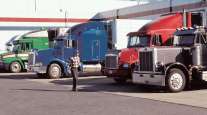Some Fleets Raise Owner-Operator Pay
This story appears in the Dec. 6 print edition of Transport Topics.
A handful of truckload fleets have raised owner-operator pay as the driver market tightens.
Increases for owner-operators took effect Dec. 5 at Schneider National Inc.’s tanker division and late in October at Knight Transportation Inc., said Gordon Klemp, a principal at the National Transportation Institute, which surveys driver pay trends.
Schneider last week announced the increase of 5 cents a mile to $1.05 for owner-operators in the Bulk Carrier Division, saying it was the company’s largest raise ever for that group of drivers. The move followed a hike of 4.4 cents a mile to $1.244 a mile for owner-operators at Knight, Phoenix.
“The driver market is tightening and it will continue to tighten moving forward,” said George Grossardt, vice president and general manager for the Schneider unit. “It has become increasingly difficult for owner-operators to get an adequate return on their investment — this increase reflects that fact.”
One sign of market tightness, he said, is the strength in spot freight markets, widely used by shippers, brokers and owner-operators. Postings on TransCore’s load board rose at least 65% above 2009 levels in August, September and October, (click here for previous story).
“We have had double-digit growth in 2010 and are expecting the same in 2011,” Grossardt said. “Our customers need long-haul chemical carriers who are committed to this market.”
Pay for company drivers in the tanker unit has been raised as well, but Schneider didn’t give details.
The company hasn’t made across-the-board pay increases, though earlier this year it offered a $10,000 signing bonus for team drivers.
The increase could add $6,250 a year to owner-operators’ pay based on the average of 125,000 miles they drive annually, the Schneider statement said.
Driver issues have taken center stage this month as the Federal Motor Carrier Safety Administration prepares to release information about carrier safety performance to the public on Dec. 12.
Some observers, such as consulting firm FTR Associates, have estimated at least 5% of the industry’s current driver corps won’t be able to find work because of their poor safety record under the agency’s new Compliance, Safety and Accountability, or CSA, program.
“It is highly likely that having your pick of drivers with the best historical safety records is a very wise move right now as we move into the CSA enforcement stage,” Klemp said.
“While we have seen some movement in company driver wages over the last year, we have seen almost no moves on the owner-operator side,” Klemp told Transport Topics.
So far this year, barely 1% of carriers Klemp surveyed have raised owner-operator pay, compared with about 10% who have raised wages for company drivers. NTI’s survey covers more than 350 fleets, most of which use owner-operators.
He estimated that 80% of truckload fleets have restored recession-related pay cuts this year for company drivers, in addition to the 10% that have announced increases.
“As companies win new freight contracts, they are finding it increasingly difficult to hire owner-operators,” Klemp said.
“The biggest problem in getting owner-operators to follow the work [to a new carrier] is that there is more freight out there for owner-operators than the number of drivers available to haul it.”
Other fleets are fine-tuning owner-operator compensation.
Con-way Truckload raised pay 7 cents a mile for those drivers, while making simultaneous changes in its fuel reimbursement and bonus pay formulas. Total compensation didn’t change, spokesman Gary Franz said.




